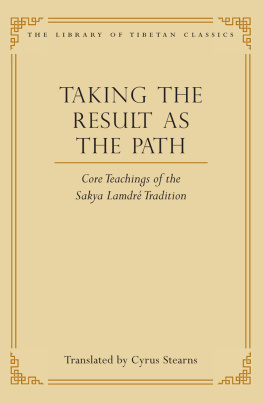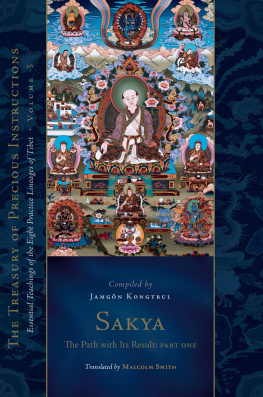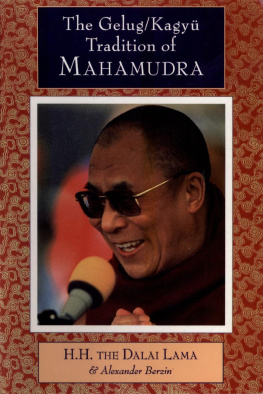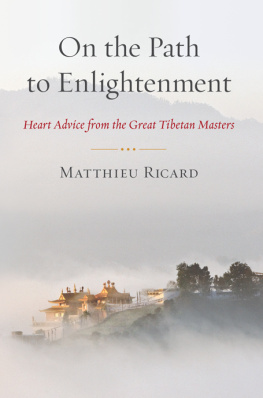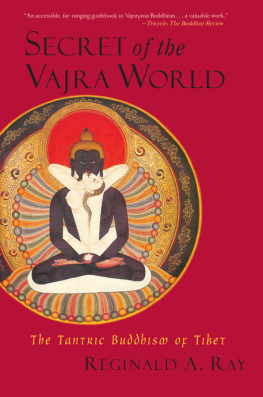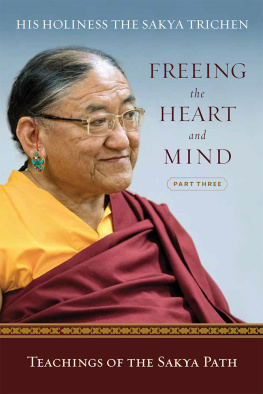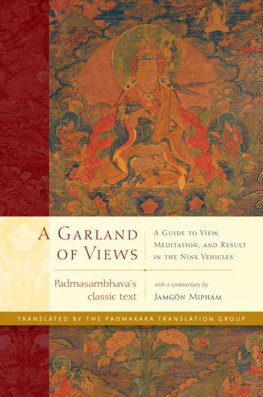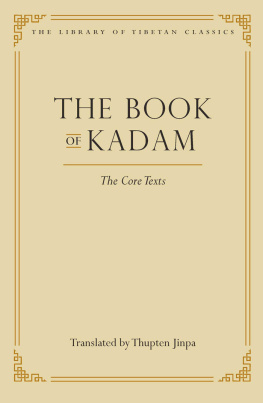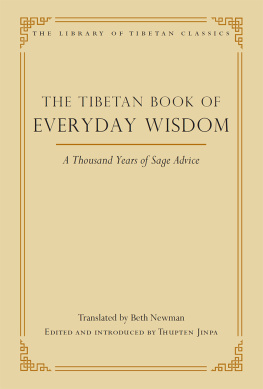T AKING THE R ESULT AS THE P ATH
The Library of Tibetan Classics is a special series being developed by THE INSTITUTE OF TIBETAN CLASSICS aimed at making key classical Tibetan texts part of the global literary and intellectual heritage. Eventually comprising thirty-two large volumes, the collection will contain over two hundred distinct texts by more than a hundred of the best-known Tibetan authors. These texts have been selected in consultation with the preeminent lineage holders of all the schools and other senior Tibetan scholars to represent the Tibetan literary tradition as a whole. The works included in the series span more than a millennium and cover the vast expanse of classical Tibetan knowledgefrom the core teachings of the specific schools to such diverse fields as ethics, philosophy, psychology, Buddhist teachings and meditative practices, civic and social responsibilities, linguistics, medicine, astronomy and astrology, folklore, and historiography.
Taking the Result as the Path
The tradition known as the Path with the Result or Lamdr (lam bras) is the most important tantric system of theory and meditation practice in the Sakya school of Tibetan Buddhism. This volume contains an unprecedented compilation of eleven vital works from different periods in the history of the Path with the Result in India and Tibet. The Vajra Lines of the great Indian adept Virpa (ca. seventheighth centuries) is the basic text of the tradition and is said to represent the essence of all the Buddhist tantras in general and the Hevajra Tantra in particular. Sachen Knga Nyingpos (10921158) Explication of the Treatise for Nyak is a fundamental commentary on Virpas succinct work and is among the earliest texts written in Tibet to explain Virpas mystical words. The collection of six writings by Jamyang Khyents Wangchuk (152468) includes a definitive history of the tradition and detailed explanations of its meditation practices as taught by his great master, Tsarchen Losel Gyatso (150266). A supplement to Khyentss history, written in the nineteenth century by Knga Palden and completed by Jamyang Loter Wangpo (18471914) in the early twentieth century, tells the stories of later masters in the lineage. An instruction manual composed by the Fifth Dalai Lama (161782) completes the unfinished work of Khyents Wangchuk. The volume concludes with a summation of all the teachings. Mangth Ludrup Gyatso (152396), another of Tsarchens principal Dharma heirs, composed this brief and eloquent text.
Most of these writings traditionally have been considered to be of a secret nature. The present translation has been made with the personal approval and encouragement of His Holiness Sakya Trizin, head of the Sakya tradition, and Chogy Trichen Rinpoch, head of the Tsarpa branch of the Sakya tradition.

Wisdom Publications
199 Elm Street
Somerville MA 02144 USA
www.wisdompubs.org
2006 Institute of Tibetan Classics
All rights reserved.
First Edition
11 10 09 08 07 06
6 5 4 3 2 1
No part of this book may be reproduced in any form or by any means, electronic or mechanical, including photography, recording, or by any information storage or retrieval system or technologies now known or later developed, without permission in writing from the publisher.
Library of Congress Cataloging-in-Publication Data
Taking the result as the path : core teachings of the Sakya lamdr tradition / translated and edited by Cyrus Stearns.
p. cm.
Includes bibliographical references and index.
ISBN 0-86171-443-1 (hardcover : alk. paper)
eBook ISBN 978-0-86171-777-4
1. Lam-'bras (Sa-skya-pa) 2. Sa-skya-pa (Sect)Doctrines. I. Stearns, Cyrus, 1949BQ7672.4.T35 2006
294.3420425dc22
2006027197
Cover & interior design by Gopa &Ted2, Inc.
Plate on page 12: Detail from a thangka of four Lamdr lineage holders; Tibet, fifteenth century. (Tibet Collection: Barbara and Walter Frey, Zurich, F753)
Message from the Dalai Lama
T HE LAST TWO MILLENNIA witnessed a tremendous proliferation of cultural and literary development in Tibet, the Land of Snows. Moreover, due to the inestimable contributions made by Tibets early spiritual kings, numerous Tibetan translators, and many great Indian paitas over a period of so many centuries, the teachings of the Buddha and the scholastic tradition of ancient Indias Nland monastic university became firmly rooted in Tibet. As evidenced from the historical writings, this flowering of Buddhist tradition in the country brought about the fulfillment of the deep spiritual aspirations of countless sentient beings. In particular, it contributed to the inner peace and tranquillity of the peoples of Tibet, Outer Mongoliaa country historically suffused with Tibetan Buddhism and its culturethe Tuva and Kalmuk regions in present-day Russia, the outer regions of mainland China, and the entire trans-Himalayan areas on the southern side, including Bhutan, Sikkim, Ladakh, Kinnaur, and Spiti. Today this tradition of Buddhism has the potential to make significant contributions to the welfare of the entire human family. I have no doubt that, when combined with the methods and insights of modern science, the Tibetan Buddhist cultural heritage and knowledge will help foster a more enlightened and compassionate human society, a humanity that is at peace with itself, with fellow sentient beings, and with the natural world at large.
It is for this reason I am delighted that the Institute of Tibetan Classics in Montreal, Canada, is compiling a thirty-twovolume series containing the works of many great Tibetan teachers, philosophers, scholars, and practitioners representing all major Tibetan schools and traditions. These important writings will be critically edited and annotated and will then be published in modern book format in a reference collection called The Library of Tibetan Classics, with their translations into other major languages to be followed later. While expressing my heartfelt commendation for this noble project, I pray and hope that The Library of Tibetan Classics will not only make these important Tibetan treatises accessible to scholars of Tibetan studies, but will create a new opportunity for younger Tibetans to study and take interest in their own rich and profound culture. Through translations into other languages, it is my sincere hope that millions of fellow citizens of the wider human family will also be able to share in the joy of engaging with Tibets classical literary heritage, textual riches that have been such a great source of joy and inspiration to me personally for so long.
The Dalai Lama
The Buddhist monk Tenzin Gyatso
Special Acknowledgments
T HE I NSTITUTE OF T IBETAN C LASSICS expresses its deep gratitude to Claus Hebben for generously providing the entire funding for this translation project.
We also acknowledge the Hershey Family Foundation for its generous support of the Institute of Tibetan Classics projects of compiling, editing, translating, and disseminating key classical Tibetan texts through the creation of The Library of Tibetan Classics.
Contents
Head of the Sakya Order of Tibetan Buddhism

T HE PITH INSTRUCTIONS of the precious and profound Lamdr teachings were received by the great mahsiddha Virpa directly from Vajra Nairtmy herself. Ever since then, they have passed down from master to disciple in an unbroken stream of transmission for well over a thousand years. These teachings were transmitted to Tibet by the great translator Drokmi Shkya Yesh.
Next page
